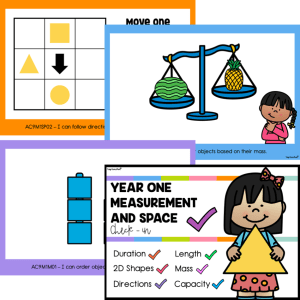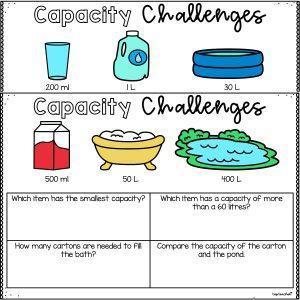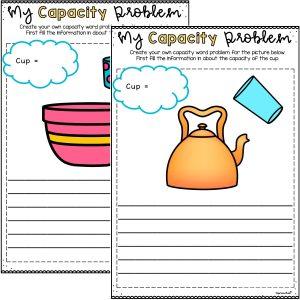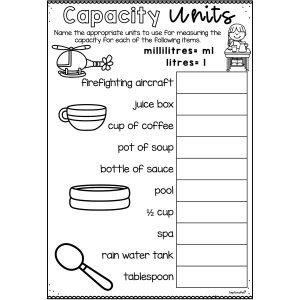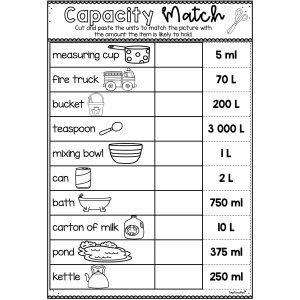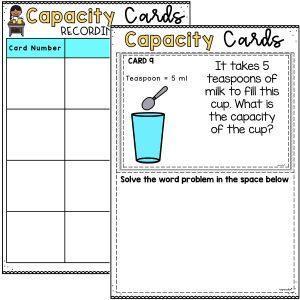Capacity Worksheets
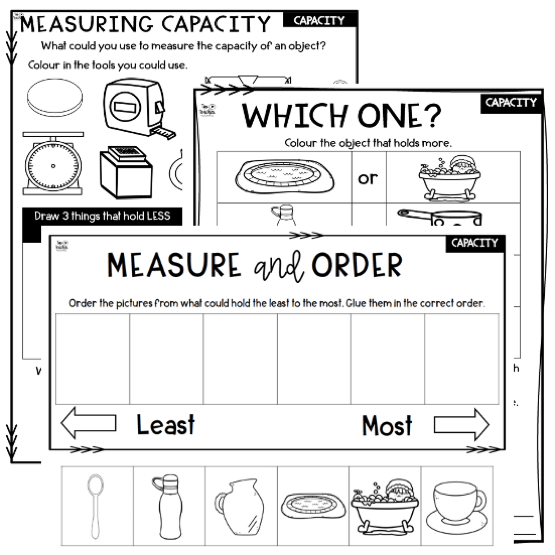
Description
Looking for a no-prep way to help your students explore the concept of capacity? Our Measure and Order Capacity Worksheets are just the ticket! This three-page set is perfect for consolidating understanding of how to estimate, measure, compare and order liquid volumes in everyday containers. Whether you’re teaching informal units or transitioning into formal measurement language like millilitres and litres, these worksheets support it all in a practical and engaging way.
Each worksheet has been designed with real-world application in mind, using familiar objects and scenarios to make the learning meaningful and memorable. Students will work through a range of tasks that require them to compare the capacities of different containers, match them to estimates or labelled measurements, and finally, place them in order from least to most capacity. It’s a great way to build visual understanding and introduce key vocabulary like ‘full’, ‘empty’, ‘holds more’ and ‘holds less’.
The tasks are accessible enough for independent work but can also be used in whole-class modelling, small group support, or fast finisher folders. Because the worksheets use simple line drawings and clear instructions, students can easily focus on the maths – not the layout – and teachers can quickly check for understanding.
Key Learning Outcomes:
- ✅ Recognise and describe capacity using comparative language (full, empty, holds more/less)
- ✅ Estimate and measure capacity using informal and standard units
- ✅ Order a set of objects by capacity
- ✅ Develop familiarity with millilitres and litres
- ✅ Apply measurement concepts in a visual and contextualised format
What’s Included:
- Three differentiated capacity worksheets targeting key learning outcomes:
- – Worksheet 1: Measuring Capacity – match objects to a capacity scale
- – Worksheet 2: Which One? – identify which container holds more or less
- – Worksheet 3: Ordering Capacity – cut, sort and order images by volume
- Clear illustrations to support visual learners
- Simple formatting that supports independent use
Materials Needed:
- Printed worksheets (single-sided for ease of use)
- Pencils, scissors and glue (for the cut-and-paste ordering task)
- Optional: measuring jugs or real containers for a hands-on introduction
How to Use:
- Use the worksheets during your measurement unit as consolidation tasks
- Introduce each worksheet with a class discussion or shared example
- Allow students to work independently or in pairs, depending on their level of confidence
- Discuss different ways of estimating and comparing volumes as a class after completion
- Use student work as a springboard for display or a follow-up hands-on capacity activity
Ideas for Classroom Use:
- 💡 Print and laminate the worksheets for use in your measurement rotation tubs
- 💡 Pair with hands-on measuring tools to support kinaesthetic learners
- 💡 Use as a pre-assessment to gauge what your students already know
- 💡 Invite students to bring a container from home and estimate its capacity before using the worksheet
- 💡 Encourage discussion and peer support by having students explain their reasoning to a partner
Top Teacher Tips:
- 💛 Enlarge worksheets to A3 size for extra visibility and group work
- 💛 Laminate and reuse the cut-and-paste ordering page with Velcro dots or magnets
- 💛 Extend your students by asking them to estimate actual measurements in millilitres
Our Measure and Order Capacity Worksheets are an ideal way to bring your capacity lessons to life – offering flexibility, visual support, and meaningful learning all in one easy-to-use printable pack!
Additional information
| Australian Curriculum Code | AC9M1M01, AC9M1M02, AC9M2M01 |
|---|---|
| File Format |
Australian Curriculum V9
F - 6
Lorem ipsum dolor sit amet, consectetur adipiscing elit.
Lorem ipsum dolor sit amet, consectetur adipiscing elit.
Lorem ipsum/ Lorem ipsum/ Lorem ipsum
Lorem ipsum dolor sit amet, consectetur adipiscing elit.
Lorem ipsum dolor sit amet, consectetur adipiscing elit.
Lorem ipsum/ Lorem ipsum/ Lorem ipsum
Lorem ipsum dolor sit amet, consectetur adipiscing elit.
Lorem ipsum dolor sit amet, consectetur adipiscing elit.
Lorem ipsum/ Lorem ipsum/ Lorem ipsum
Lorem ipsum dolor sit amet, consectetur adipiscing elit.
Lorem ipsum dolor sit amet, consectetur adipiscing elit.
Lorem ipsum/ Lorem ipsum/ Lorem ipsum
Lorem ipsum dolor sit amet, consectetur adipiscing elit.
Lorem ipsum dolor sit amet, consectetur adipiscing elit.
Lorem ipsum/ Lorem ipsum/ Lorem ipsum
